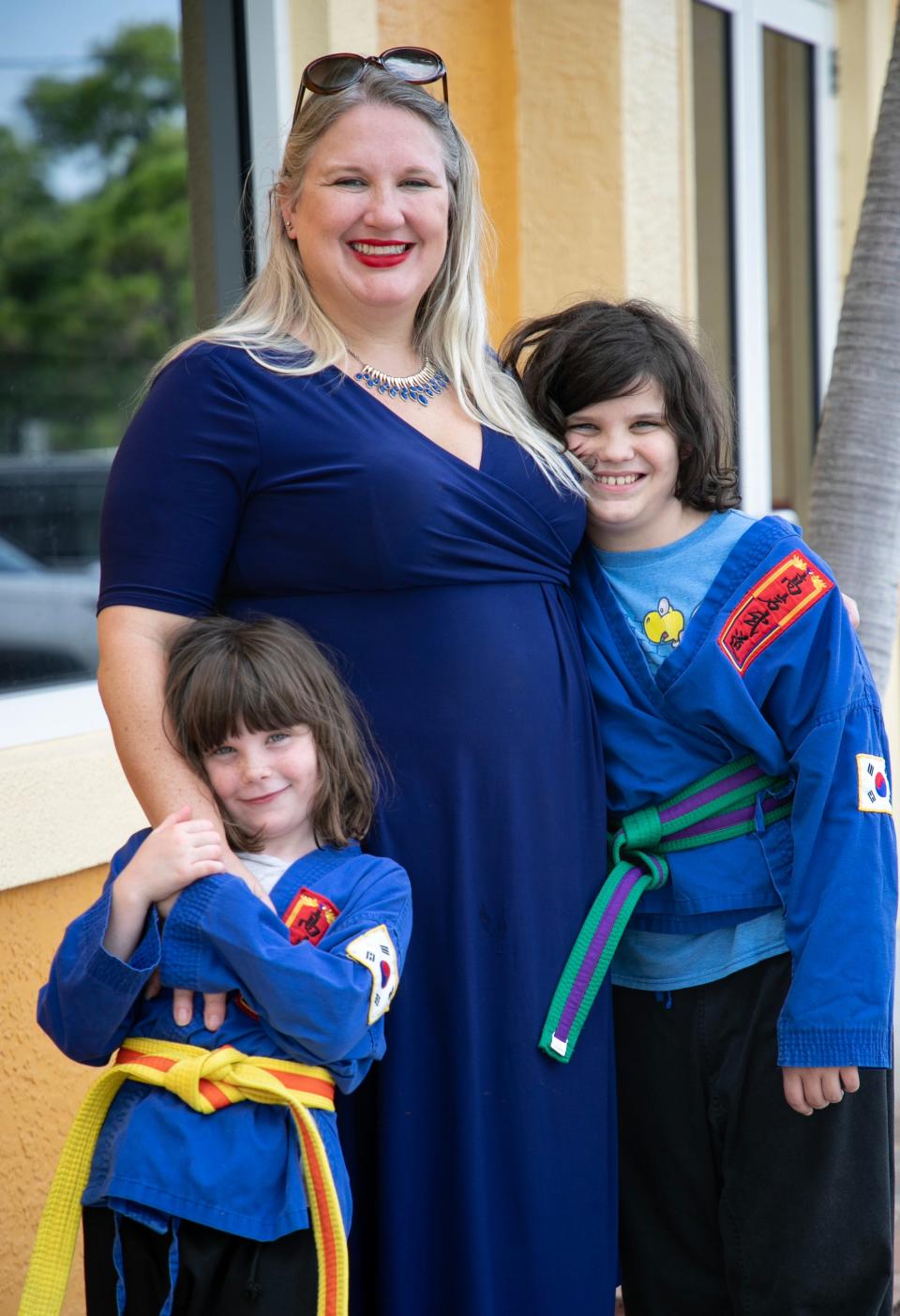Fort Myers' carcinogenic air pollution may be fixed, but what about those exposed for years?
Do residents, workers and hundreds of children at three Fort Myers schools have increased cancer risks after years of exposure to carcinogenic air pollution? One mom whose daughter had a rare blood disease worries it may have been caused by exposure to the potent chemical.
Yet answers ‒ and tests that might offer them ‒ have proven hard to come by for those concerned about ethylene oxide released in a south Fort Myers neighborhood for more than a decade with no public notice.
Worry surged about the gas, referred to as EtO, used to sterilize medical equipment at a plant on Adelmo Lane in Fort Myers, after the U.S. Environmental Protection Agency began blitzing nearby mailboxes in late June.

Turns out the LeeSar/American Contract Systems facility, which uses it to kill pathogens, had been discharging the invisible gas through its stacks into the surrounding neighborhood. The fallout zone mapped by EPA includes schools, other businesses and homes.
Ethylene oxide is nasty stuff. According to the EPA, when inhaled it causes cancers in humans including lymphoid cancer plus tumors of the brain, lung, connective tissue, uterus. “Human occupational studies have shown elevated cases of lymphoid cancer and, also breast cancer in female workers," it reports.
Residents learned they'd been exposed to the stuff for a dozen years. They learned that the plant was releasing "high levels" of the chemical and that 2016 data revealed it is "more toxic than previously understood," that "certain communities near commercial sterilizers could have elevated cancer risks due to lifetime exposures" and that the federal agency had "serious concerns." And if residents wanted to add their comments to a proposed federal rule change about the chemical, they had just days to do so, the agency said.
What followed was a whirlwind of hastily convened online public meetings and media coverage.
'Serious concerns': 'No safe level': Fort Myers plant pollutes air with a carcinogenic chemical, EPA warns
'Immediate impact on the long-term risk'
A Facebook group, EtO Free Future, formed. A town hall held by U.S. Congressman Byron Donalds of Naples turned into an impromptu forum on the situation. But by early July, the company said it had installed new emissions controls, Donalds had toured the plant to inspect them, then released a memo that said the new dry bed scrubbers were 99.9% effective in removing the chemical.
EPA spokesman James Pinkney concurred, writing in an email to The News-Press: "This reduction will have an immediate impact on the long-term risk in the community.”
The Florida Department of Environmental Protection added the controls "reduce the risk well below the threshold used in EPA’s modeling. With these new controls installed and operational, DEP anticipates that EPA will remodel this facility to confirm the reduced risk to the community."
In a note to parents, Montessori School of Fort Myers Head James Farwell, who attended Donalds' town hall, wrote that since the company had agreed to install the emission scrubbers, "My read on the situation at this point is that we have arrived at a good outcome to a bad situation. The efficacy of the scrubbers and the distance of our school from the emitter make me feel safe having my entire family at our school every day. I understand that some of you will remain concerned and I respect that."
But what about all those years of previous, unchecked exposure? Answers are in short supply.
Could lawsuits be on the horizon?
After reading about the emissions, FGCU instructor and environmental advocate Cindy Banyai realized "My kids have been going to school in that zone basically the whole time of exposure," attending Fort Myers Montessori as well as after-school programs at United Martial Arts, both of which are in the zone.
Banyai's youngest daughter Evie, now 6, came down with autoimmune hemolytic anemia, a disease for which there's no family history, she says. "This just came on all of a sudden," she said. "It was a two-year battle in and out of the hospital, the ICU, the ER, six blood transfusions, four rounds of chemotherapy, (hospitalized) almost a month with respiratory failure. She was intubated and sedated for several weeks and she had a seizure. It was a lot ... I still owe the hospital tens of thousands of dollars."
Because the disease was unexpected, Banyai had always wondered if the disease had a possible environmental cause. "Why else would there be this disease that was never present in our family and just kind of came on?"
At the EPA meeting, "It just kind of all clicked and came together: This could be related to Evie's blood disease, especially considering the time of exposure ... younger children are more susceptible to EtO exposure."
Though she's tried to find tests that might gauge her kids' past exposure and future risk, so far she's been unsuccessful.
Banyai said before the EPA notice, she had no idea about the pollution. The company, the school, state agencies ‒ none worked to inform people of the risks, she says, and that's not right. "I'm exploring with some attorneys the potential for a lawsuit or even a class-action lawsuit."
What's ethylene oxide? American Contract Systems: What we know about Fort Myers plant, emissions EPA is warning about
She's not the only parent with lingering concerns. Beverly Harvey, whose child attends Evangelical Christian School, also close to the plant, wants to know if the scrubbers will be monitored and whether their installation “resets the range on the areas that are considered unsafe to breathe?" Plus, she wonders if there is a breach in the function, will the public know?
Fort Myers Montessori parent Alex Horn has the same questions. She was disappointed in the "lackluster response" to her and others' questions. "My biggest concern is that we are being forced to put our blind trust in a company who chose to look the other way in emitting carcinogenic gas for 11 years over a community and multiple schools," Horn wrote in an email. "There is no third-party monitoring, there is no secondary monitoring system or fence-line monitors, there is no accountability that ACS will report equipment malfunction, or that the scrubbers are even effective in real-time. We were told that scrubbers will reduce emissions by 99%, but where is the proof that they are preventing emissions over the Villas neighborhood? Where is the transparency that their mitigation efforts are effective?"
'We’ve had our fill and (are) very disheartened'
The mood in the Facebook group was decidedly grim.
Its most recent post, made by the administrators late Wednesday said, "All involved passed the buck, said it wasn’t in their jurisdiction and referred us in circles."
It speculated about potential political gains and concluded, "There was no accountability to the residents and students by the company or the government to those exposed for the last 12 years. It’s sad and potentially with fatal results for those exposed and not receiving proper screening for their increased risk of cancer.

"As a group of parents and physicians who have never run in the political world, we’ve had our fill and (are) very disheartened. We are sorry all of our efforts were outsmarted but it wasn’t without ruffling the feathers of those at the highest levels of these agencies and having them make a concerted effort to suppress us. We at least were a formidable force."
Want a test? Get ready to do some work
To questions about testing or how people can determine cancer risk based on past exposure, the EPA has some confusing answers.
The News-Press emailed Pinkney to ask where someone in the exposure zone can get tested to determine their potential risk. "I.e. If a person who’s lived or worked or gone to school in the area wants to know if they’re going to have an increased chance of cancer, where can they get a test?"
Pinkney wrote back: "According to the Agency for Toxic Substances and Disease Registry there are two kinds of tests that can determine if you have been recently exposed to ethylene oxide. One test measures ethylene oxide in blood and the other test measures it in your breath. However, these tests are not intended for use on individuals who may have been exposed to very low levels of EtO, because the tests are not sensitive enough to detect it. These tests cannot be used to predict whether or not a recent exposure to EtO might affect a person’s health. Because special equipment is needed, these tests aren’t included in a typical physical exam.
He continued: "If you have health concerns that you believe are related to EtO exposure, start by contacting a health care provider. In addition, the Agency for Toxic Substances and Disease Registry (ATSDR) can tell you the location of occupational and environmental health clinics. These clinics specialize in recognizing, evaluating, and treating illnesses resulting from exposure to hazardous substances.
"You can reach ATSDR at: 1-800-CDC-INFO. If you are concerned about EtO and your child’s health, contacting your health care provider is a good place to start. If your provider is not familiar with EtO, they can work with you to contact the Pediatric Environmental Health Specialty Unit (PEHSU) that serves your area. EPA and the ATSDR help fund the PEHSUs, which are a source of medical information and advice on environmental conditions that influence reproductive and children’s health. If you don’t have a doctor, you can contact the PEHSU for your area directly."
Following up, The News-Press wrote back to ask Pinkney why he wrote the tests weren't for people with low-level exposure when the EPA itself has characterized the Fort Myers plant’s previous emissions as high. "What about that?," The News-Press asked, "And any idea how much this kind of testing costs?"
He did not immediately respond.
This article originally appeared on Fort Myers News-Press: Carcinogenic pollution in Fort Myers curbed, but what damage was done?

